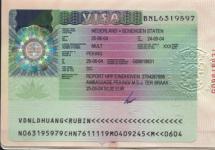Read the article and watch the video - this will be enough to understand what and how it is considered.
Many airlines found themselves in a difficult situation. According to the current rules, if a traveler arrives in a visa country without being entitled to it, the air carrier is obliged to return him to his homeland at his own expense. That is, now, if you have arrived, say, in Germany, but cannot pass the visa control, the carrier is obliged to return you back at his own expense.
Previously, before checking in for a flight, airline representatives only looked at visas for their validity. It was easy - only valid visas were taken into account. Now having a valid visa is not enough. And it is impossible to calculate the days of stay only by the stamps of the tourist in the passport. Many border guards put blurry and unreadable stamps.
The border guards themselves have the opportunity to “break through” the tourist through the common Schengen bases, the airlines are deprived of this opportunity. So the work increased for everyone, especially since no one informed many tourists with already valid visas.
The topic is very important, because under the new rules you may not be released even with a freshly obtained visa. At the same time, when issuing visas, no one should warn you, and even more so, calculate the terms for you based on the validity of old visas, sometimes obtained in other countries.
Let's figure it out. I will try to state the problem and its solutions as accessible as possible. The previous rules, as you know, assumed that the duration of a tourist's stay in the Schengen area on one or more trips with a multiple-entry visa, starting from the moment of the first entry, cannot exceed 90 days within six months. What did it mean? The fact that the number of days allowed to stay extended to each half year from the date of the first entry into one of the Schengen countries. All calculations were made in advance and old visas could be ignored.
What has changed now? The number of allowed days is the same - 90. And the period is the same - 180 days. Only now the validity period is counted not forward from the moment of the first entry on a valid visa, but backward - from the day the start of each new trip. And if you have exhausted the limit, then even applying for a new visa will not help, since all previous trips are summed up and taken into account.
The easiest way to understand this is graphically. Let's take a look at the pictures together. The main parameter is how many days you have been in the Schengen visa area in the last 180 days.
Some explanations for the picture:
B– Date of planned entry into the Schengen area.
A– Settlement date (from date B we count 180 days ago).
Yellow squares with numbers in the interval A-B - the time spent in the Schengen area, possibly in different countries.
Please note that there is no date of receipt of visas anywhere in the picture. In this case, it is irrelevant information. Only the possibility of staying in the Schengen area depends on the period of validity of the visa. It has no effect on the calculations.
Line 1. In total, for the billing period (180 days), you stayed in the Schengen area for 41 days. Your trip is possible - you still have 49 days left. For longer trips you will not be allowed. Taking into account the visa paradox, you can stay in the Schengen area 49 + 15
days.
Line 2. You have been in the Schengen area for 81 days. Your trip is only possible for 9 days. They won't let you in for 15 days.
Line 3. You have been in the Schengen zone for 90 days. Actually, you can't go anywhere. even with a new open visa.
What to do in this situation?
1. Wait until the furthest previous trip is included in the previous 180-day period, thus granting additional allowed days of stay in the Schengen area.
2. Or you can wait 90 days, and then, according to the new rules, all previous trips of the 180-day period "burn out", a new countdown begins.
By the way, the new rules apply only to the Schengen countries. This rule does not apply to Bulgaria, Croatia, Ireland, Romania, Cyprus and the UK. These countries are not part of the Schengen area. And of course it does not apply to other countries of the world.
I am sure that such a detailed explanation will not raise any additional questions. I really hope that the members of our club will not get into a difficult situation when crossing the border.
Finally, a small paradox. Probably not everyone will understand him, but this allows, according to the new rules, to stay in the Schengen area for more than 90 days. It consists in the following. If at the time of the start of the calculation (point A) you were in the Schengen zone, then even if you have already spent 89 days in the Schengen, you can still stay there for some time.

Let's get a little more detailed.
Line 5. You have stayed in Schengen for 89 days and it would seem that you can enter no more than a day. But in a day it turns out that you again stayed in Schengen for only 89 days and you can stay like this for up to 27 days (until they are deducted in the calculations)
Line 4. You have a few more days left. In this case, they are summed up and you can stay there up to 32 days in total.
I understand that not everyone will understand this paradox. Special thanks to Alexander Khilchenko for him - he described his work in detail in the comments to this article. (There is a link to the article) I recommend reading it.
We look forward to your comments, additions and questions, if any. I will definitely answer all.
Click on the "Like" button and send this article to your friends. Help your friends figure it out. Until now, many travelers are lost in these calculations.



